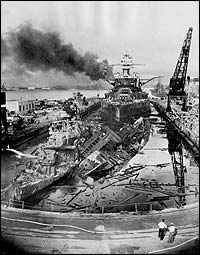| By Mark Fritz / Globe Staff / April 15, 2001 |
 |
They were acquaintances who shared an appreciation of art, antiques, and the strange forces that moved the world. But those forces were now moving to ruin a friendship, not to mention a large piece of the planet.
 In the foreground are two destroyers, the USS Cassin (left) and the USS Downes, that were battered in their Pearl Harbor drydock by Japanese bombs. In the rear, relatively undamaged, is the battleship USS Pennsylvania, which was also in drydock. (US Navy photo)
In the foreground are two destroyers, the USS Cassin (left) and the USS Downes, that were battered in their Pearl Harbor drydock by Japanese bombs. In the rear, relatively undamaged, is the battleship USS Pennsylvania, which was also in drydock. (US Navy photo)
|
In November 1941, Malcolm Lovell was a real estate developer in New York and a Quaker dedicated to nonviolence. Hans Thomsen was Nazi Germany's top envoy to the United States. War was raging, but Hitler still had a mission in Washington. The Americans were neutral, but they were supplying aid to the Allies and denying it to the Axis.
Thomsen was telling Lovell things that sounded like messages to an intermediary. He said Germany will clearly conquer Europe. Japan is gobbling up Asia, though it's spread thin. It needs to cover its rear and protect its supply lines. It needs to attack the United States.
''If Japan waits, it will be comparatively easy for the United States to strangle Japan,'' Thomsen told Lovell. ''Japan is therefore forced to strike now, whether she wishes to or not.''
Lovell ultimately passed everything Thomsen told him on to William ''Wild Bill'' Donovan, the US intelligence chief. Donovan threw it into the flow of data flooding Franklin D. Roosevelt, a president walking the thin line between tacit involvement and quasi-isolation, all the while listening to conflicting advice on the infinite outcomes of endless possibilities. Three weeks later, the picture became clear. Japan sent a sky full of combat aircraft to the Hawaiian Islands and bombed the bulwark of the Navy's Pacific fleet. Within hours, Pearl Harbor was history.
Some researchers contend, and many people assume, that FDR saw the punch coming and let it land, that only sailors and sea birds were surprised when the Imperial Navy destroyed an army airfield and a naval base. Lovell's warning, detailed in a cluster of new records recently declassified by the CIA, would seem to be a tantalizing little ingredient to toss into the long-simmering stew of arguments that support one of history's most provocative debates: whether Roosevelt sacrificed Pearl Harbor to incite isolationist Americans into going to war.
Actually, the raw and rushed exchange of World War II correspondence now being declassified will give more ammuniton for people to argue whatever proposition they want to make. What the records do show clearly is how unclear the future looked to the decision makers.
''Their world was a lot grayer,'' says military historian Edward J. Drea, an expert on Imperial Japan and the author of ''MacArthur's ULTRA: Codebreaking and the War Against Japan, 1942-1945.'' ''They were clueless to the outcome. We know the outcome. Today, we're reading their history backward. At the time, they were simply going forward.''
Pearl Harbor has become one of the century's great conspiracy theories. It is to the so-called Greatest Generation what the assassination of President John F. Kennedy is to the baby boomers that returning servicemen sired.
 In the foreground are two destroyers, the USS Cassin (left) and the USS Downes, that were battered in their Pearl Harbor drydock by Japanese bombs. In the rear, relatively undamaged, is the battleship USS Pennsylvania, which was also in drydock. (US Navy photo)
In the foreground are two destroyers, the USS Cassin (left) and the USS Downes, that were battered in their Pearl Harbor drydock by Japanese bombs. In the rear, relatively undamaged, is the battleship USS Pennsylvania, which was also in drydock. (US Navy photo)


